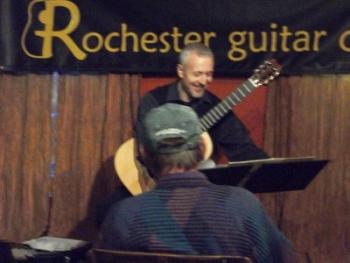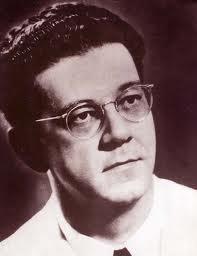Petar Kodzas’ Presentation “Music of Brazilian Composer Radames Gnattali,” May 16 2011
RGC members in attendance on Monday, May 16 at Abilene’s were treated to a treatise on Brazilian music by Professor Petar Kodzas, ECMS. (Eastman Community Music School) Prof. Kodzas is familiar to us having presented and played for the Club several times over the last few years.

Petar Kodzas
Petar’s discussion was marked by his thorough knowledge, yet relaxed and engaging manner of relating to the audience. Petar began the evening telling us about his first exposure to Brazilian music. He had heard Bossa Nova in his home as a child, and during his college years found a tape (remember tapes?) of guitarist Louis Bonfá. That was enough for him to fall in love with the characteristic rhythms, articulation and variety of colors of Brazilian music. Petar also listened extensively to guitarist Antonio Carlos Jobim. Both of these guitarists used what is widely termed “Brazilian Rhythm” which includes the Bossa Nova, the Samba and the Choro. It has been suggested that Brazilian composer Villa Lobos’ Etude #1 would have a Bossa Nova rhythm if the accents were placed in the bass notes.
The discussion of Brazilian rhythm led to the topic of the influences and history of Brazilian music. Brazilian music, by and large, is a composite of classical, jazz, national and folk music. The mid-nineteenth century European influence is seen in the use of names and forms of music such as Polka and Mazurka. These pieces where played in the streets with guitars and other instruments closely related to the guitar. Around 1850 this music became more specifically Brazilian. At that time, there were five main types of guitar in various regions of Brazil, all in different tunings. Other influences in Brazilian music include African rhythms and indigenous tribal music styles. One of the characteristic features of African music is the hemiola, i.e., two against three rhythms. Indigent music is characterized by an economy of melody, interesting melodies comprising only a few notes. There is always something new in Brazilian music to the western ear such as seventh chords built on top of each other. Another characteristic type of local music is Choro, a nostalgic, yearning style of music that is improvised, strolling polyphonic music comprising several voices much like Dixieland music in the U.S.

Radames Gnattali
Petar’s specific focus has been on Brazilian composer Radames Gnattali, having spent several years researching, studying and interpreting his music. Gnattali was not primarily a guitar composer, but did compose several important scores for the instrument. Gnattali, was born in Porto Alegre in 1906, son of Alessandro Gnattali and Adélia Fossati, both successful musicians from Italy. Radames was named by his parents for an Egyptian king in Verdi’s opera “Aida.” He studied piano, violin and later composition, traveling to Sao Paolo and throughout the country, eventually settling in Rio de Janeiro in 1931.
In Rio, he wrote music for radio shows, and to earn extra money, began to write arrangements, play piano and write popular music. In Brazil, folk and pop were in much the same category until around 1930. Radames started writing music for guitar in the 1960s including solo, duet, trio, chamber, and concerto pieces. Among the solo guitar pieces he wrote there was a set of ten studies. Each of the studies is dedicated to a different guitarist friend. He has been little recorded, although some of his music was published by Laurindo Almeida and Carlos Barbosa Lima. Gnattali passed away in 1988.
Gnattali’s music is neither easy to read nor easy to play. It is full of chromaticism and many unexpected twists and turns. Enchromatic notation is frequently used for identical pitches, such as A# and Bb. The format is typically ABA sometimes with minor variations and occasionally introductions and codas. The music sometimes requires double barrés, something seldom encountered in classical music. Much of the music is arpeggiata in format. Petar has experimented with bringing out different parts of the arpeggio for a variety of affects in the music. He has been challenged by how to interpret much of the music, more broadly or tighter? Sometimes the solution is to change the style on the repeat. What does Brazilian music really sound like? Are we playing it as we have heard other Westerners play it or are we playing in an authentic Brazilian style? It is often hard to tell. Thus, Petar’s challenge is that of a Serbian guitarist playing Brazilian music in America! Petar brought his exposition to a dramatic conclusion with a pair of toccatas.
The present reviewers, not being versed in Brazilian music, none the less, found the results very appealing! We look forward to Petar’s participation in the presenters’ concert on June third. See the calendar of events on this website for details. Petar interspersed his discussion with well executed examples of Gnattali’s music. Here is the play list.
Study #1
Study #3
Little Suite Movements: I - pastoril; II - toada; III - frevo
Saudade
Dansa Brasileira
Suite Brazilian #13 Movements: I - samba bossa nova; II - valsa; III - choro
Toccata em ritmo de samba No. 1
Toccata em ritmo de samba No. 2
—P. Schickling/R. Taglieri
Photos: R. Taglieri
Share this page: ![]() Facebook
Facebook
![]() Del.icio.us
Del.icio.us
![]() StumbleUpon
StumbleUpon
![]() Digg
Digg
![]() Reddit
Reddit
Home ::
About Us ::
Events ::
Articles ::
Resources ::
Contact Us ::
Links
©2007-2012, Rochester Guitar Club, All Rights Reserved, This page last updated 2013-11-13 11:11:34
Website by Red Beagle Web Development.








